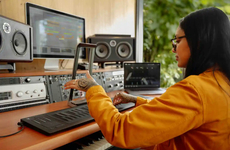
Robotic Marimba Player Improvises With Human Piano Player
Geebee Micro — April 28, 2009 — Tech
References: engadget
In a rendition of Duke Jordan’s “Jordu,” we hear for the first time the piece played by a human, while the robot marimba player named “Shimon” improvises.
Simon was created by Roberto Aimi of Alium Labs, Guy Huffman and Gil Weinberg, head of Georgia Tech Center for Music Technology.
How it works is the robot hears how the human is playing, and through an improvisation system based on gesture, along with a motor control system, attempts to go along with the movements of the human player, as you can hear and see in the video.
All in all the robot musician does a pretty good job of following and interacting with the piece.
Simon was created by Roberto Aimi of Alium Labs, Guy Huffman and Gil Weinberg, head of Georgia Tech Center for Music Technology.
How it works is the robot hears how the human is playing, and through an improvisation system based on gesture, along with a motor control system, attempts to go along with the movements of the human player, as you can hear and see in the video.
All in all the robot musician does a pretty good job of following and interacting with the piece.
Trend Themes
1. Robotic Improvisation - The trend of robots being able to improvise and interact with human musicians opens up new opportunities for collaborative performances and creative expression.
2. Gesture-based Systems - The trend of using gesture-based systems to enable robots to respond and adapt to human movements creates possibilities for enhanced human-robot interaction in various industries.
3. Music Technology Advancements - The trend of advancements in music technology, such as robotic musicians, presents opportunities for innovation and disruption in the music and entertainment industry.
Industry Implications
1. Music - The music industry can explore the integration of robotic musicians to create unique and dynamic performances.
2. Robotics - The robotics industry can develop and market gesture-based systems that enable robots to interact and collaborate with humans in creative and expressive ways.
3. Entertainment - The entertainment industry can leverage music technology advancements, like robotic improvisation, to enhance live performances and engage audiences in innovative ways.
2.6
Score
Popularity
Activity
Freshness















